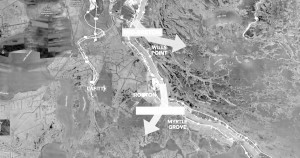La. must act fast to restore shrinking land, coastal experts warn
12th November 2018 · 0 Comments
By Susan Buchanan
Contributing Writer
People in the Big Easy are anxious. Being surrounded by water has always provided recreation. But land in and around New Orleans is sinking even faster than the ocean’s rising, making the city particularly vulnerable. Unless residents are willing to move inland, the state has little time to waste in protecting the coast, experts warn. And that will require some trade-offs.
With its 50-year, $50 billion Coastal Master Plan, the state’s pursuing multiple defenses that will work with newly rebuilt federal levees in the Orleans area. The plan, updated every five years since the first one in 2007, includes fortifying islands, building river diversions, creating marshland and bolstering landbridges.
Jacques Hebert, spokesman for Restore the Mississippi River Delta, said progress has been made, but work remains to protect New Orleans. And more money is needed. He arranged a late-October flyover of Plaquemines Parish to assess the situation.
Most of the barrier islands south of Orleans were rebuilt in recent years by the state with federal assistance, according to Alisha Renfro, a coastal scientist with the National Wildlife Federation, working on the Restore the Mississippi River Delta campaign. That includes Scofield, Shell and Pelican Islands in Plaquemines, along with Caminada Headland to the west in Lafourche. Together, they’ll help defend Plaquemines, Jefferson, Orleans, St. Bernard and Lafourche parishes against winds and storm surge.
At this juncture, the state’s Coastal Protection and Restoration Authority is preparing to build the Mid-Barataria Sediment Diversion in Plaquemines on the west side of the Mississippi near Ironton. It will be followed by creation of the Mid-Breton Sediment Diversion on the east bank. The water’s silt, clay and minerals will be used to make land. Oystermen are wary, however, fearing estuaries will be hurt by changes in water salinity and temperatures, along with inflows of pollutants.
Since year 2000, land has been built in south Louisiana. On the October 29 flight from New Orleans down to Venice and back, Renfro pointed out new greenery in Plaquemines in the midst of blue water. Traveling with pilot Emmet Bartholomew on a plane provided by North Carolina-based SouthWings, Mardi Gras Pass was visible in the Bohemia Spillway.
The pass, 35 miles southeast of New Orleans at river mile 43.7, was created by erosion in the 2011 floods and is a new outlet of the Mississippi on its east side. Sediment moves through the pass into Bay Uhlan in Breton Sound. Foliage has grown on acres of new mud flats, Renfro said. This natural diversion was possible because levees had been removed to create the spillway in 1926. Asked whether oyster reefs died from the recent sediment, Renfro said the beds there hadn’t been very productive since the 2010 Gulf spill and possibly earlier.
At river mile 43 on the Mississippi’s east side, she pointed to the Delta Management at Fort St. Philip project. Completed in 2006 under the Congressional Coastal Wetlands Planning, Protection and Restoration Act of 1990, the project had made small crevasses, allowing river sediment to flow into shallow water. Earthen terraces were built to capture that sediment, creating land in the Bay Denesse area.
An initial decline was seen in oysters as land built at Mardi Gras Pass and Fort St. Philip, but that may have been related to previous over-harvesting and to impacts from the 2010 oil spill, John Lopez, coastal sustainability director with the Lake Pontchartrain Basin Foundation, said from his office last week. “A potential recovery in oysters there very recently is partly inhibited by salinity, and that’s dominantly from Fort St. Philip,” he said.
On the river’s east side, down near Venice, is Pivach Cut—which is just up from Baptiste Collette. The cut is a channel that was dredged from the river in 2004, connecting it to shallow water. The channel was made to offset wetlands impacts from waterfront development near the community of Happy Jack, Renfro said. The channel has deposited sediment and filled in more than 50 acres of shallow water.
South of Venice on the Mississippi’s west side is the Locust Pond Crevasse. It was once a small opening from the river’s Tiger Pass outlet. The crevasse has expanded over time, depositing sediment and building new land.
In 2003, a cut was dredged from the river’s east bank six miles south of Venice into the shallow water of West Bay by the U.S. Army Corps of Engineers. In 2009, material dredged from the nearby Pilottown area was used to make sediment-enhancement retention devices or SREDs. After the 2011 floods, new land emerged in West Bay, and more greenery has appeared as additional SREDs have been built.
Renfro said these new, emerald areas show that the nearly 100 million tons of sediment flowing through Plaquemines yearly from the Mississippi can be harnessed to build wetlands. The Mid-Barataria Sediment Diversion is one of the most studied projects in the state’s history. She believes that diversions are critical to sustaining the state’s wetlands.
After pilot Bartholomew landed the plane safely in New Orleans, Jacques Hebert said that Bayou Bienvenue in the Lower Ninth Ward would offer a good perspective on the coast from inside the city. We headed out to that once-thriving cypress swamp and looked at its dead stumps. The bayou had turned saltier, killing its vegetation, after the Army Corps built the MRGO channel in 1968. The MRGO was mostly closed in 2009, but the bayou still awaits restoration.
Residents want the old swamp’s trees and grass back to protect them from hurricanes and coastal shrinkage, said Arthur Johnson, executive director of the Lower Ninth Ward Center for Sustainable Engagement & Development, as he stood on the bayou’s observation deck.
After Katrina, community groups called for a new deck overlooking Bayou Bienvenue. Students, professors and others built one in 2009. The perch has been full of visitors ever since, keeping interest in coastal restoration alive, bayou watcher Bill Waders said from the platform.
State-federal restoration efforts like the Orleans Landbridge and the Golden Triangle Marsh Creation projects should refresh the bayou eventually, according to Johnson. “But we’re further down on the food chain than some other projects,” he said.
High on the chain is the $1.3 billion Mid-Barataria Sediment Diversion, proposed by CPRA for river mile 60 in Plaquemines. This large-scale, civil works project is in the design-engineering phase now and awaits a full environmental assessment, required by federal law, according to CPRA engineer Kodi Guillory. She had driven down to Bayou Bienvenue from Baton Rouge that morning with CPRA colleague Seth Irby.
Under the plan, up to 75,000 cubic feet per second of sediment-laden water would be diverted from the Mississippi in high-river periods to the Mid-Barataria Basin to re-establish a natural, deltaic process. During the rest of the year, a flow of 5,000 cubic feet per second is proposed. A gate or gates would control the water. An influx of silt, freshwater and nutrients is expected to sustain wetlands and reduce land loss in Plaquemines and Jefferson parishes.
In January, the Trump Administration approved speeding up the permitting process for the Mid-Barataria diversion. An Environmental Impact Statement is being prepared now by a third-party CPRA contractor, Gulf Engineers & Consultants in Baton Rouge, in coordination with the Army Corps to consider potential impacts, Guillory said. A draft EIS will be published in the Federal Register late next year. CPRA could obtain federal permits for the diversion within the next two years, and construction might begin in 2021, she said.
A $700 million Mid-Breton Sediment Diversion is slated for Plaquemines on the east bank near Wills Point at mile 69. Engineering and design has started and will run concurrently with the permitting process, Guillory said. Construction could begin soon after the engineering phase and permitting are complete.
In the last two years, CPRA has held over 75 meetings with thousands of fishermen, property owners and other community members at churches, bait shops and elsewhere in Plaquemines and surrounding parishes, to answer questions and address concerns about these diversions, said Seth Irby, a CPRA diversion program outreach coordinator.
From her office last week, Natalie Peyronnin Snider, science policy director for the Mississippi River Delta Restoration at the Environmental Defense Fund in Washington, said an operations working group that she’s part of gave Louisiana recommendations about how to balance land building with ecosystem needs. One suggestion for diversions was to take advantage of wintertime. “A lot of important commercial and recreational species can withstand lower salinities when water temperatures are lower,” she said. “But that doesn’t mean that we shouldn’t operate diversions in spring and summer, when total sediment is highest.”
Financing these new diversions and other state restoration projects is a challenge. Louisiana doesn’t have the $50 billion needed to implement the Coastal Master Plan in its entirety, Charles Allen, engagement director at the National Audubon Society, said at Bayou Bienvenue. “But billions of dollars from the BP spill settlement, the Gulf of Mexico Energy Security Act and other sources have provided a jump start to get large-scale projects constructed,” he said. Recent, historically sizable efforts include the Caminada Headland and Barrier Island restoration project near Port Fourchon in Lafourche Parish, along with Whiskey Island’s restoration in Terrebonne Bay. Funding from current sources will get more projects finished in the next decade.
The state has to remain focused on large-scale, science-based projects to get the most bang for its buck, Allen said. And Louisiana’s leaders need to keep advocating for more funding from Washington, while trying to make the state’s coast a national priority. Louisiana legislators must see that funds earmarked for coastal restoration are in fact used for that purpose. In this and other years, lawmakers have eyed CPRA funds to help fill state budget deficits.
Among CPRA’s funding sources is the federally-run Natural Resource Damage Assessment. It determines how much harm an oil spill did and then works to restore natural resources. The total NRDA settlement from the 2010 Deepwater Horizon disaster was $8.8 billion, and of that Louisiana will pocket at least $5 billion over time. In addition, the state is slated for over $930 million in RESTORE Act funding after the spill. That’s under a 2012 law, directing 80 percent of Clean Water Act penalties from the spill to Gulf Coast restoration.
Through the Gulf of Mexico Energy Security Act of 2006, Louisiana benefits from an arrangement sharing 37.5 percent of federal offshore oil and gas revenue with oil-producing Gulf states. And the Pelican State gets over $80 million yearly now from the Coastal Wetlands Planning Protection and Restoration Act of 1990. Additionally, the state’s been awarded $1.27 billion by the National Fish and Wildlife Foundation’s Gulf Environmental Benefit Fund for barrier island restoration and sediment diversions.
Natalie Snider at EDF said not acting on restoration would be devastating to south Louisiana’s communities, wildlife and estuaries. Sediment diversions can keep fisheries productive for a much longer period than a river without diversions would, she said.
The state’s Coastal Master Plan estimates that without significant action, nearly 300 square miles or 55 percent of the land left in Plaquemines Parish now would be gone in 50 years. Statewide, 2,006 square miles of coast disappeared from 1932 to 2016, according to the U.S. Geological Survey last year.
If you’d like to help the coast, consider volunteering, Jacques Hebert said. In early December, volunteers are needed in Plaquemines to bag discarded oyster shells from New Orleans restaurants to refresh reefs. To learn more, visit Coalition to Restore Coastal Louisiana at www.crcl.org on the web.
This article originally published in the November 12, 2018 print edition of The Louisiana Weekly newspaper.




